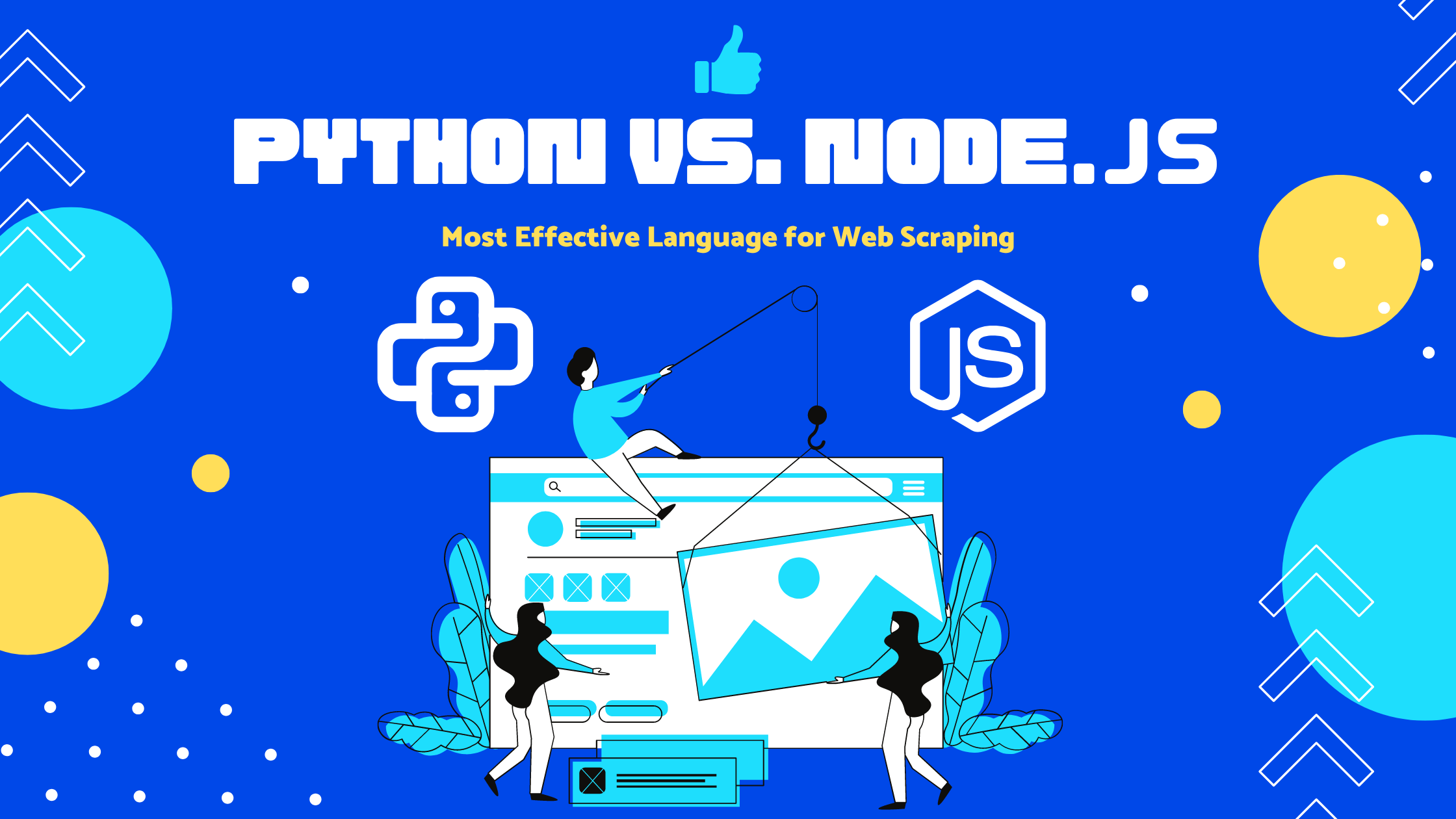In the world of AI and LLMs, we have seen web scraping as an essential skill in one’s toolkit and from a career growth perspective, it’s is a very important skill to develope. Web/Data Scrapping allows you to gather valuable data from websites for analysis, monitoring, and a multitude of other use cases.
So, when it comes to choosing a technology for web scraping, two programming languages stand out: Python and Node.js (JavaScript). In this article, we will dive deep into the pros and cons of using Python and Node.js for web scraping, exploring their libraries, learning curve, handling dynamic HTML or web data, code flexibility, and real-world examples.
So, let’s get started!
Python for Web Scraping 🐍
Libraries and Tools
Python is widely regarded as the go-to language for web scraping due to its simplicity, versatility, and an extensive collection of libraries. One of the most popular libraries for web scraping in Python is Beautiful Soup. It allows you to parse HTML or XML web pages effortlessly and extract the required data with just a few lines of code. Another powerful library is Scrapy, which provides a complete framework for web scraping, including crawling, data extraction, and data storage.
Learning Curve
Python has a relatively gentle learning curve, making it an excellent choice for beginners. Its syntax is easy to understand, and there are numerous online resources and tutorials available to help you get started. Additionally, Python has a large and supportive community, which means you can find help and guidance whenever you encounter challenges during your web scraping journey.
Handling Dynamic HTML or Web Data
When it comes to handling dynamic HTML or web data, Python provides various solutions. One of them is Selenium, a framework that allows you to automate web browsers and interact with web elements. Selenium is particularly useful when dealing with websites that heavily rely on JavaScript for content rendering. With Selenium, you can simulate user interactions, click buttons, fill out forms, and scrape dynamic content effectively.
Code Flexibility
Python is known for its flexibility, allowing you to write concise and readable code. It supports multiple programming paradigms, such as procedural, object-oriented, and functional programming. This flexibility enables you to adapt your code to different scraping scenarios and easily incorporate additional functionalities or data processing steps into your web scraping workflow.
Example: Scraping Product Prices
Let’s take a real-world example to demonstrate how Python can be used for web scraping. Suppose you want to scrape product prices from an e-commerce website. Here’s a sample code snippet that uses Beautiful Soup to extract the product names and prices:
import requests
from bs4 import BeautifulSoup
def get_product_prices(url):
try:
# Send an HTTP GET request to the product listing page
response = requests.get(url)
response.raise_for_status() # Check if the request was successful
# Parse the HTML content of the page using BeautifulSoup
soup = BeautifulSoup(response.content, 'html.parser')
# Find all product elements on the page
products = soup.find_all('div', class_='product')
# Extract and print the name and price of each product
for product in products:
name = product.find('h2').text.strip() # Strip extra whitespaces
price = product.find('span', class_='price').text.strip()
print(f'Product: {name} - Price: {price}')
except requests.exceptions.RequestException as e:
print(f"Error during request: {e}")
except Exception as e:
print(f"An unexpected error occurred: {e}")
# Example usage
product_listing_url = 'https://www.example.com/products'
get_product_prices(product_listing_url)
In this example,
- The code is encapsulated into a function (
get_product_prices) for better structure and reusability. - Added error handling using
try-exceptblocks to catch and handle any potential errors during the request or parsing process. - Used
response.raise_for_status()to check if the HTTP request was successful. - Applied
strip()to remove leading and trailing whitespaces from the extracted text.
The code is concise, easy to understand, and allows you to scrape the desired data efficiently.
Node.js for Web Scraping
Libraries and Tools
Node.js (JavaScript) has gained popularity in recent years for web scraping due to its event-driven, non-blocking I/O model and the availability of powerful libraries. One of the most widely used libraries for web scraping in Node.js is Cheerio. It provides a jQuery-like syntax for HTML parsing and manipulation, making it easy to extract data from web pages. Another popular library is Puppeteer, which allows you to control a headless browser and scrape dynamic content effectively.
Learning Curve
If you are already familiar with JavaScript, the learning curve for web scraping with Node.js will be relatively smooth. JavaScript is a widely used programming language, and there are abundant online resources and tutorials available to help you get started with Node.js. However, if you are new to JavaScript, there might be a steeper learning curve compared to Python.
Handling Dynamic HTML or Web Data
Node.js, with libraries like Puppeteer, excels at handling dynamic HTML or web data. Puppeteer allows you to interact with web pages, click buttons, fill out forms, and scrape content that is rendered dynamically using JavaScript. This makes Node.js a great choice for scraping websites with complex JavaScript interactions.
Code Flexibility
JavaScript, the language used in Node.js, is known for its versatility and flexibility. It supports multiple programming paradigms, including functional and object-oriented programming. This allows you to write code that is both concise and expressive. Additionally, Node.js has a vast ecosystem of packages and modules, providing you with a wide range of tools to enhance your web scraping workflow.
Example: Scraping News Headlines
Let’s take another real-world example to showcase how Node.js can be used for web scraping. Suppose you want to scrape news headlines from a news website. Here’s a sample code snippet that uses Cheerio to extract the headlines:
const axios = require('axios');
const cheerio = require('cheerio');
const scrapeNewsHeadlines = async (url) => {
try {
// Make an HTTP GET request to the news website
const response = await axios.get(url);
// Load the HTML content of the page using Cheerio
const $ = cheerio.load(response.data);
// Extract news headlines
const headlines = $('.headline').map((index, element) => $(element).text()).get();
console.log(headlines);
} catch (error) {
console.error('Error during scraping:', error.message);
}
};
// Example usage
const newsUrl = 'https://www.example.com/news';
scrapeNewsHeadlines(newsUrl);
In this example,
- The code in an asynchronous function (
scrapeNewsHeadlines) for better readability and to handle promises more efficiently. - Used
awaitwithaxios.getto simplify promise handling. - Replaced the
eachmethod withmapfor concise code and to directly retrieve an array of headlines. - Provided more detailed error handling and reporting, including the error message.
This code demonstrates the simplicity and effectiveness of Node.js for web scraping tasks.
Python vs Node.js: Which is the Ultimate Winner?
Choosing between Python and Node.js for web scraping ultimately depends on your specific requirements and familiarity with the programming languages. Here’s a summary of the key factors to consider:
| Factor | Python | Node.js |
|---|---|---|
| Libraries and Tools | Beautiful Soup, Scrapy | Cheerio, Puppeteer |
| Learning Curve | Gentle learning curve, beginner-friendly | Requires some prior knowledge of JavaScript |
| Dynamic HTML Handling | Selenium | Puppeteer |
| Code Flexibility | Versatile and readable | Benefits from JavaScript’s widespread use |
In conclusion, Python is widely regarded as the go-to language for web scraping due to its simplicity, extensive libraries, and supportive community. It is an excellent choice for beginners and offers flexibility in handling different scraping scenarios. Node.js, on the other hand, excels at handling dynamic content and provides powerful tools for scraping websites with complex JavaScript interactions.
If you are already familiar with JavaScript, Node.js can be a great choice. Ultimately, the decision between Python and Node.js depends on your specific requirements and preferences as a Data Engineer.
Remember, web scraping should always be conducted ethically and in compliance with the website’s terms of service.
Happy scraping!






